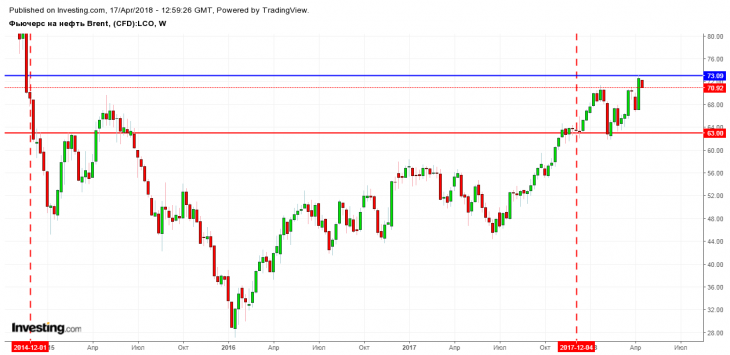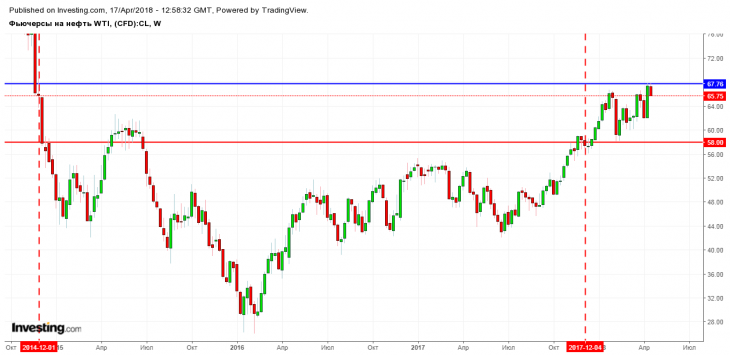
Ринок нафти і його основні драйвери в 2018 році. Олександр Сiвцов.
У 2018 році ринок нафти зберіг позитивний настрій, при цьому з грудня 2017 року ціни на нафту марок Brent і WTI в середньому виросли приблизно на $ 10, оновивши максимальні значення з грудня 2014 року.
Тепер давайте розглянемо основні фактори, які впливають на формування цін на нафту в 2018 році.

Мал. 1 Графік марки Brent з грудня 2014 року по квітень 2018 року

Мал. 2 Графік марки WTI з грудня 2014 року по квітень 2018 року
Ринок нафти: Пакт ОПЕК +
Природно, основну підтримку нафтовому ринку чинило дотримання пакту ОПЕК +, згідно з яким видобутокф нафти повинна скоротитися на 1,8 млн. барелів на добу, з яких на частку ОПЕК лягає 1,2 млн. барелів на добу, на Росію 300 тис. барелів на добу і ще 300 тис. на 10 країн поза картелем.
- Згідно крайнiм звітом МЕА, в березні виконання квот щодо скорочення обсягів видобутку з боку ОПЕК було на рівні 161% або на 1,932 млн. барелів на добу, що вже перевищує загальну квоту пакту ОПЕК + в розмірі 1,8 млн. барелів на добу.
Росія ж була настільки добросовісна і виконала свої зобов’язання на 82%. Варто відзначити, що дотримання пакту ОПЕК + на 161% з боку картелю, в основному, було досягнуто за рахунок скорочення видобутку в Анголі, Венесуелі, Алжирі та Саудівській Аравії.
Відносно країн ОПЕК, які перевиконують план по скороченню обсягів видобутку нафти, варто виділить Венесуелу, де видобуток нафти продовжує стрімко знижуватися через що розгорілась фінансова криза. Пакт ОПЕК + був укладений в листопаді 2016 року, на той час видобутока нафти у Венесуелі була на рівні 2,4 млн. барелів на добу. У березні 2018 обсяг видобутку в Венесуелі знизився до рівня 1,488 млн. барелів на добу, або на 912 тис. барелів на добу, що становить 47% від загального скорочення обсягів видобутку картелю в березні. Нехитрий підрахунок говорить про те, що не всі члени ОПЕК дотримуються квоти на 100%, так як при цьому скорочення видобутку в рамках картелю в березні перевищувало б 2,1 млн. барелів, що цілком можливо в майбутньому.
Ринок нафти: Геополітична нестабільність
Ще одним фактором, який надає підтримку ринку нафти в 2018 році, є геополітична напруженість на Близькому Сході. Близький Схід є центром світового нафтоекспорту і перебої поставок з даного регіону різко скоротять пропозицію на ринку, що підтримає подальше зростання цін на нафту. 11 квітня Саудівська Аравія перехопила балістичні ракети, випущені повстанцями в Ємені, якi, як вважається, підтримує Іран. Дії Ірану можуть загрожувати країні новими санкціями з боку США, які можуть вплинути на поставки нафти з країни, що також надасть підтримку подальшому зростанню цін на нафту.
Ринок нафти: Зростання видобутку нафти в США
Чи не кожен день на різних інтернет ресурсах з’являється інформація про те, що зростання видобутку нафти в США продовжує зростати, що повинно нівелювати ефект від пакту ОПЕК + і збільшити пропозицію сировини на ринку, тим самим вчинивши тиск на ціни, але при цьому картина, яку ми бачимо, зовсім не така.
- Згідно зі звітом МЕА, видобуток нафти в США в березні виросла до 14,41 млн. барелів на добу, в той час як в 2017 році видобуток нафти була на рівні 13,19 млн. барелів на добу і це зростання ще далеко не межа.
В основному зростання видобутку нафти в США був досягнутий за рахунок розробки сланцевих родовищ. У свою чергу, залишається відкритим питання, чому ж зростання видобутку нафти в США практично не чинить тиск на ринок нафти, тут є 3 основних причини:
- Попит на сланцеву нафту не так вже й велик, так як більшість нафтопереробних заводів світу не можуть з нею працювати, для чого потрібно їх переобладнання.
- На виході з сланцевої нафти готових продуктів виходить менше, ніж з інших сортів. Природно ціна сланцевої нафти нижче, ніж її конкурентів, але це не може компенсувати в короткі терміни витрат на переобладнання заводів.
- Доставка нафти з США за океан. Природно, прокласти трубопровід з Америки в Європу або Азію неможливо, для чого поставку нафти коштує здійснювати за допомогою танкерів, що здорожує її транспортування і робить ще більш невигідною для використання в Європі чи Азії.
Висновок
Роблячи висновки по даній статті, можна сміливо зазначити, що зростання цін на нафту може продовжитися в 2018 році, так як кількості факторів, що підтримують зростання цін на нафту, більше, ніж факторів що чинять тиск.
Олександр Сiвцов
Багато інших тем шукайте на сайті в Блозі Трейдера!
А якщо у вас є пропозиція – про що написати в наступній статті – пишіть нам на пошту info@esterholdings.com!